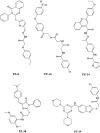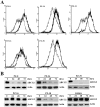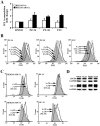Dynamic vs static ABCG2 inhibitors to sensitize drug resistant cancer cells
- PMID: 21151870
- PMCID: PMC2998423
- DOI: 10.1371/journal.pone.0015276
Dynamic vs static ABCG2 inhibitors to sensitize drug resistant cancer cells
Abstract
Human ABCG2, a member of the ATP-binding cassette transporter superfamily, plays a key role in multidrug resistance and protecting cancer stem cells. ABCG2-knockout had no apparent adverse effect on the development, biochemistry, and life of mice. Thus, ABCG2 is an interesting and promising target for development of chemo-sensitizing agents for better treatment of drug resistant cancers and for eliminating cancer stem cells. Previously, we reported a novel two mode-acting ABCG2 inhibitor, PZ-39, that induces ABCG2 degradation in addition to inhibiting its activity. In this manuscript, we report our recent progresses in identifying two different groups of ABCG2 inhibitors with one inhibiting only ABCG2 function (static) and the other induces ABCG2 degradation in lysosome in addition to inhibiting its function (dynamic). Thus, the inhibitor-induced ABCG2 degradation may be more common than we previously anticipated and further investigation of the dynamic inhibitors that induce ABCG2 degradation may provide a more effective way of sensitizing ABCG2-mediated MDR in cancer chemotherapy.
Conflict of interest statement
Figures







Similar articles
-
A novel two mode-acting inhibitor of ABCG2-mediated multidrug transport and resistance in cancer chemotherapy.PLoS One. 2009 May 24;4(5):e5676. doi: 10.1371/journal.pone.0005676. PLoS One. 2009. PMID: 19479068 Free PMC article.
-
New use for an old drug: inhibiting ABCG2 with sorafenib.Mol Cancer Ther. 2012 Aug;11(8):1693-702. doi: 10.1158/1535-7163.MCT-12-0215. Epub 2012 May 16. Mol Cancer Ther. 2012. PMID: 22593228
-
Overcoming ABCG2-mediated drug resistance with imidazo-[1,2-b]-pyridazine-based Pim1 kinase inhibitors.Cancer Chemother Pharmacol. 2015 Oct;76(4):853-64. doi: 10.1007/s00280-015-2858-9. Epub 2015 Sep 9. Cancer Chemother Pharmacol. 2015. PMID: 26351135
-
Multidrug resistance in cancer chemotherapy and xenobiotic protection mediated by the half ATP-binding cassette transporter ABCG2.Curr Med Chem Anticancer Agents. 2004 Jan;4(1):31-42. doi: 10.2174/1568011043482205. Curr Med Chem Anticancer Agents. 2004. PMID: 14754410 Review.
-
Human multidrug transporter ABCG2, a target for sensitizing drug resistance in cancer chemotherapy.Curr Med Chem. 2007;14(6):689-701. doi: 10.2174/092986707780059580. Curr Med Chem. 2007. PMID: 17346156 Review.
Cited by
-
Medically Important Alterations in Transport Function and Trafficking of ABCG2.Int J Mol Sci. 2021 Mar 10;22(6):2786. doi: 10.3390/ijms22062786. Int J Mol Sci. 2021. PMID: 33801813 Free PMC article. Review.
-
Revealing the fate of cell surface human P-glycoprotein (ABCB1): The lysosomal degradation pathway.Biochim Biophys Acta. 2015 Oct;1853(10 Pt A):2361-70. doi: 10.1016/j.bbamcr.2015.06.001. Epub 2015 Jun 6. Biochim Biophys Acta. 2015. PMID: 26057472 Free PMC article.
-
Doxorubicin and 5-fluorouracil resistant hepatic cancer cells demonstrate stem-like properties.Cytotechnology. 2013 Aug;65(4):491-503. doi: 10.1007/s10616-012-9511-9. Epub 2012 Oct 27. Cytotechnology. 2013. PMID: 23104270 Free PMC article.
-
Role of the breast cancer resistance protein (BCRP/ABCG2) in drug transport--an update.AAPS J. 2015 Jan;17(1):65-82. doi: 10.1208/s12248-014-9668-6. Epub 2014 Sep 19. AAPS J. 2015. PMID: 25236865 Free PMC article. Review.
-
Human ABCG2: structure, function, and its role in multidrug resistance.Int J Biochem Mol Biol. 2012;3(1):1-27. Epub 2011 Mar 30. Int J Biochem Mol Biol. 2012. PMID: 22509477 Free PMC article.
References
-
- Zhang JT. Biochemistry and pharmacology of the human multidrug resistance gene product, ABCG2. Zhong Nan Da Xue Xue Bao Yi Xue Ban (J Cent South Univ) 2007;32:531–541. - PubMed
-
- Xu J, Peng H, Zhang JT. Human multidrug transporter ABCG2, a target for sensitizing drug resistance in cancer chemotherapy. Curr Med Chem. 2007;14:689–701. - PubMed
-
- Xu J, Liu Y, Yang Y, Bates S, Zhang JT. Characterization of oligomeric human half-ABC transporter ATP-binding cassette G2. J Biol Chem. 2004;279:19781–19789. - PubMed
-
- McDevitt CA, Collins RF, Conway M, Modok S, Storm J, et al. Purification and 3D Structural Analysis of Oligomeric Human Multidrug Transporter ABCG2. Structure. 2006;14:1623–1632. - PubMed
Publication types
MeSH terms
Substances
Grants and funding
LinkOut - more resources
Full Text Sources

